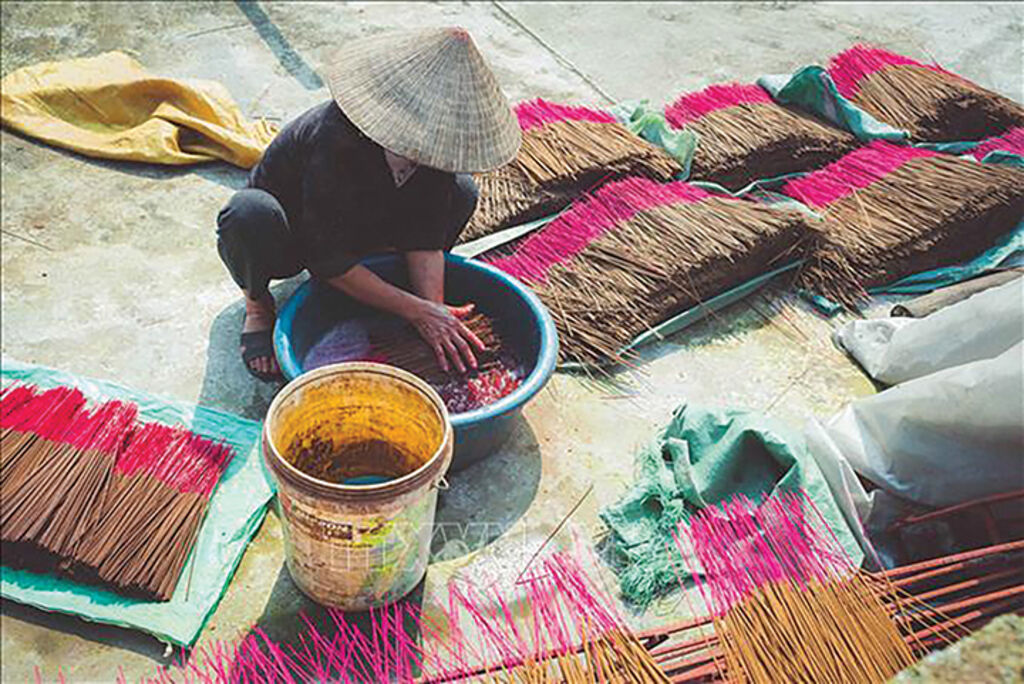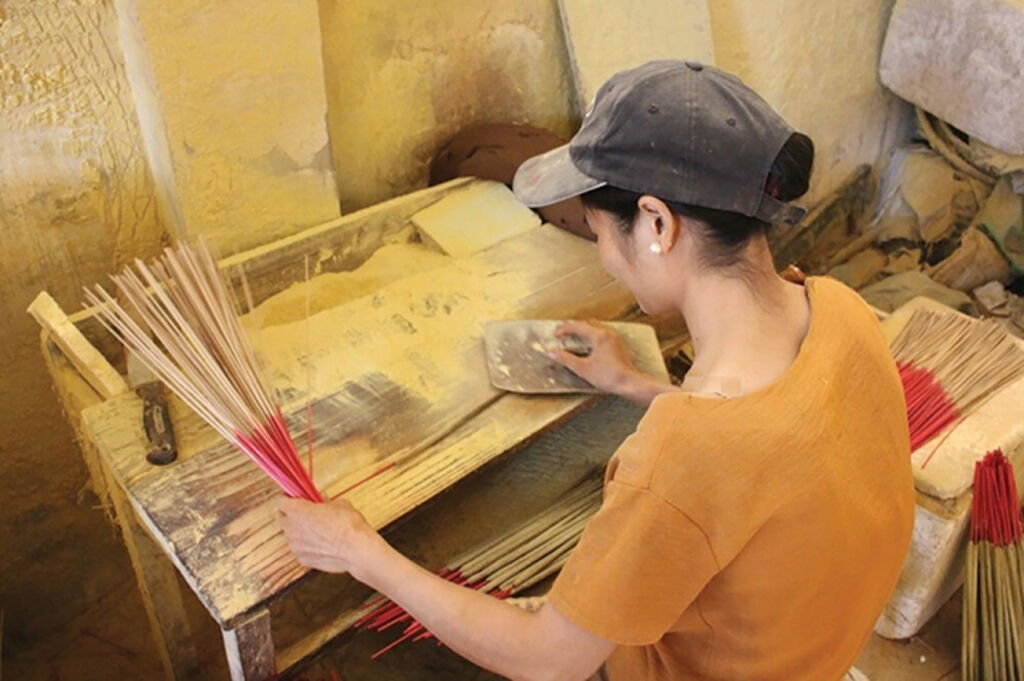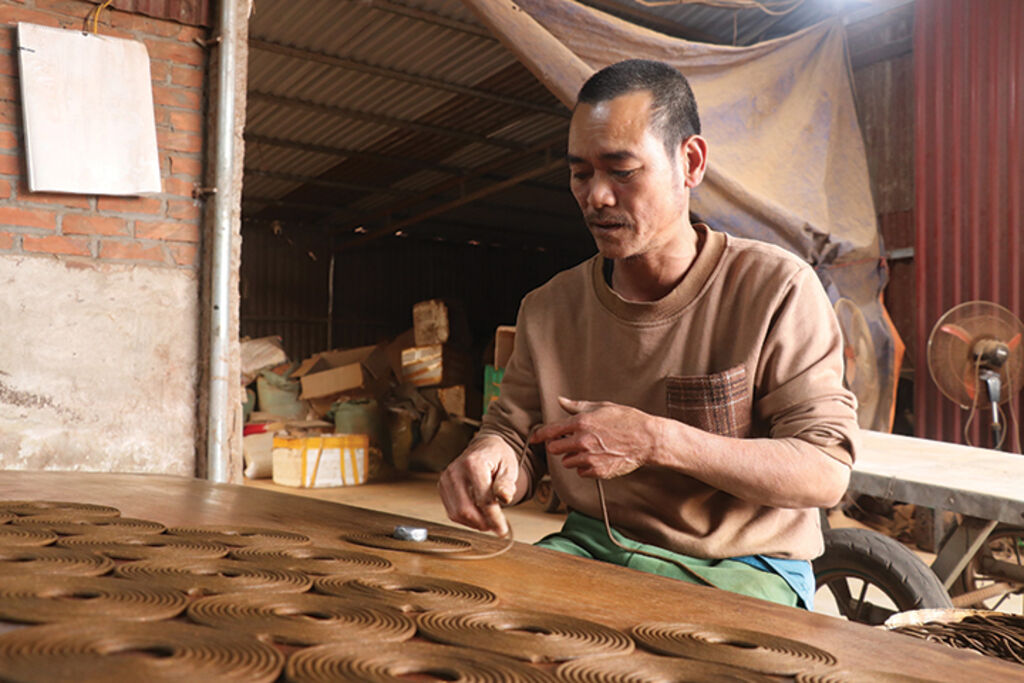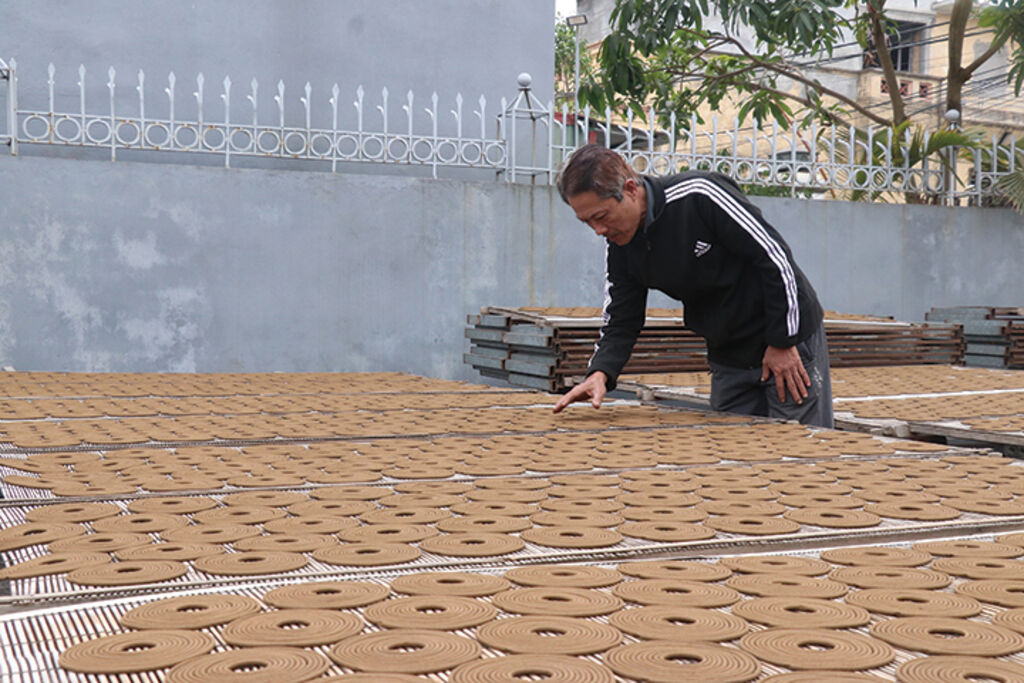 |
| Dyeing one end of bamboo sticks__Photo: Pham Kien/VNA |
Cao Thon, formerly known as Thon Cao, is a traditional incense-making village in Bao Khe commune, Hung Yen province. It is well-known for its distinctive incense sticks and coils, which feature a variety of aromas derived from traditional herbs and family secrets, both in the incense paste and its outer coating.
For generations, incense sticks have been regarded by the Vietnamese as a sacred medium connecting the world of the living with the divine. Lighting incense sticks on ancestral altars or Buddha shrines, especially during important occasions like the Lunar New Year, remains an indispensable cultural and religious practice.
It is believed that Dao Thi Khuong, a resident of the village, was the founder of the craft. In the 18th century, she traveled extensively to trade and learn the art of incense making. Upon returning home, she passed the knowledge on to her descendants and fellow villagers. Today, on the 22nd of the eighth lunar month, villagers hold an incense-offering ceremony at her temple to express their gratitude and honor her legacy.
 |
| Preparing ground powder from 36 medicinal plants__Photo: vovlive.vn |
The art of incense making from family herbal secrets
Have you ever wondered how the perfectly smooth, golden incense sticks or intricately wound incense coils of Cao Thon are made? They are not factory products; they are handcrafted by villagers who have inherited centuries-old techniques and family recipes and are dedicated to keeping these secrets alive.
The process of making incense sticks and coils involves several meticulous steps, including preparing raw materials, blending aromatic paste, and applying it to bamboo sticks (for incense sticks) or shaping it into spirals (for incense coils).
The essential materials include mature bamboo, aromatic herbs, and Styrax bark powder. The process begins with selecting quality bamboo. Villagers chop mature bamboo into long canes, then soak them in water for at least 40 days to remove impurities. Afterward, the bamboo is sun-dried and cut into smaller sticks, which are then sanded, polished, and trimmed to the exact length. These bamboo sticks are then neatly bundled and partially dipped into magenta dye, coloring just one end with a vibrant pink, and once again laid out to dry completely in the sun, to be ready for the next stage of incense production.
 |
| Rolling incense sticks__Photo: vovlive.vn |
Mixing the aromatic paste is the most critical stage, directly influencing the incense’s quality. This paste is a careful blend of water, Styrax bark powder, which acts as a natural adhesive, and finely ground powder from 36 medicinal plants. These include Chuanxiong rhizomes, Dahurian angelica roots, tree peony root bark, Chinese atractylodes rhizomes, rhubarb roots, Angelica sinensis roots, cypress bark, Bhutan cypress wood, clove buds, star anise pods, cinnamon seeds, agarwood, and others. The proportions are closely guarded family secrets passed down through generations. This mixture gives Cao Thon incense its distinctive aroma.
In the final stage, Cao Thon villagers apply the aromatic paste to the undyed portion of the bamboo sticks, and for incense coils, they shape the paste into spirals, completing the process with an outer coating.
Once shaped, the incense must be dried. Ideally, a sunny day with temperatures between 25 and 30 degrees Celsius ensures optimal drying. On cloudy days, drying takes two to three days. During the rainy season, villagers must resort to electric dryers, though the color and aroma are considered inferior to naturally sun-dried incense.
Nguyen Nhu Khanh, Chairman of the Cao Thon Traditional Incense-Making Village Association, notes: “Even with the same ingredients, hand-rolled incense sticks offer a stronger scent and more porous texture than machine-made ones. When lit, machine-made sticks produce less expansive smoke compared to hand-crafted varieties.”
 |
| Shaping blended aromatic paste into spirals__Photo: Manh Khanh/VNA |
Preserving a legacy for the future
According to Vice Chairman of the Bao Khe Commune People’s Committee Cao Van Minh, local authorities have paid due attention to promoting the craft village’s traditional values and seeking new directions for its development.
 |
| Checking sun-dried incense coils__Photo: Manh Khanh/VNA |
In particular, the province has issued thematic resolutions on the development of commercial services, focusing on the sustainable development of the craft village in tandem with tourism and service development. It has also mentioned earmarking a specific land area in its master plan for the building of new-style rural areas to support the craft village’s development. Additionally, the Hung Yen Provincial Enterprise Association has helped design a logo for the Cao Thon incense brand. With this support, Cao Thon villagers will continue to safeguard ancestral secrets, improve quality, diversify product designs, and build a strong regional and national reputation for their centuries-old craft.- (VLLF)









